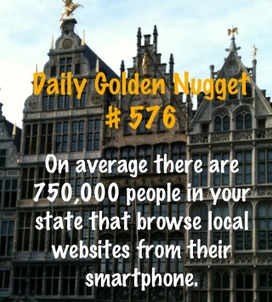 I watched a statistical video from Google last week where it said 58% of small businesses in the USA do not have websites at all, and far fewer have mobile websites. I'm always surprised by how big these numbers are because I know you can't survive in business today without an email address and a website.
I watched a statistical video from Google last week where it said 58% of small businesses in the USA do not have websites at all, and far fewer have mobile websites. I'm always surprised by how big these numbers are because I know you can't survive in business today without an email address and a website.Let me present the data that Google had that explains how often smartphone owners search for local stores on their phone, and what they do after the search.
I'm presenting information for the USA, UK, and Australia. I'm also breaking the data down by age groups of 18-29 and 30-49. I've chosen these 2 age groups because the first is typically the bridal customers, and the second group is more sophisticated, repeat jewelry buyer.
Unlike the data I presented on Friday, this data is generic across all retail industries and it hints at what you should be doing for your own jewelry store.
This first set of numbers show the percentage of people that search for local information on their smartphone either daily, weekly, monthly, less than monthly, or never.
| Daily | Daily | Weekly | Weekly | Monthly | Monthly | Less than Monthly | Less than Monthly | Never | Never | |
| 18-29 | 30-49 | 18-29 | 30-49 | 18-29 | 30-49 | 18-29 | 30-49 | 18-29 | 30-49 | |
| Australia | 21% | 17% | 35% | 28% | 25% | 28% | 9% | 14% | 11% | 12% |
| UK | 16% | 11% | 23% | 25% | 29% | 30% | 18% | 20% | 15% | 13% |
| USA | 34% | 28% | 32% | 32% | 21% | 23% | 7% | 12% | 6% | 5% |
Although the USA was slower to adopt mobile technology and smartphones than other countries, we sure have made up for lost time and adopted the daily usage quickly.
This chart show that 66% of bridal buyers in the USA are looking for local information on their phone at least once a week. 66 is an amorphous number and really doesn't relate to what happening to the people walking around outside your store, so let me try and put this into more understandable numbers.
According to Nielsen News ( http://ow.ly/egGNS ) only 40% of cell phone users in the USA have smartphones. And according to comScore there ( http://ow.ly/egH0t ) there are 114 million smartphone users in the USA. Using 114 and 66% I get 75.2 million people that browse their smartphone every week for local information. If that number seems too high to imagine I could say that it averages to 1.5 million people per state, which is slightly easier to imagine. Yes I know the population of some states, like Montana, is lower than 1M. I'm just trying to quantify these numbers so we can understand them.
Let's look now at what those 1.5 million people are doing after they search their phone for local businesses.
| Called store | Called store | Made a purchase in-store | Made a purchase in-store | Made a purchase online | Made a purchase online | Visited store | Visited store | |
| 18-29 | 30-49 | 18-29 | 30-49 | 18-29 | 30-49 | 18-29 | 30-49 | |
| Australia | 46% | 57% | 27% | 30% | 26% | 26% | 46% | 52% |
| UK | 27% | 37% | 21% | 20% | 21% | 19% | 40% | 41% |
| USA | 48% | 56% | 24% | 27% | 23% | 20% | 52% | 49% |
| Visited store website | Visited store website | Looked up on a map | Looked up on a map | No action | No action | |
| 18-29 | 30-49 | 18-29 | 30-49 | 18-29 | 30-49 | |
| Australia | 47% | 55% | 37% | 43% | 18% | 10% |
| UK | 39% | 46% | 34% | 37% | 23% | 17% |
| USA | 50% | 48% | 50% | 50% | 11% | 8% |
This data shows us that 50% of users visited the store's website, and 50% looked the store up on the smartphone's Map application. Putting this into usable numbers it would be that would be 750,000 people in your state that look at a website on their smartphone every week.
That's 750,000 reasons for you to either have a mobile website or have a website that can be used on a smartphone.
Take some time to review these charts. There's more information than what I'm pointing out here.
Source data from:http://www.thinkwithgoogle.com/mobileplanet








